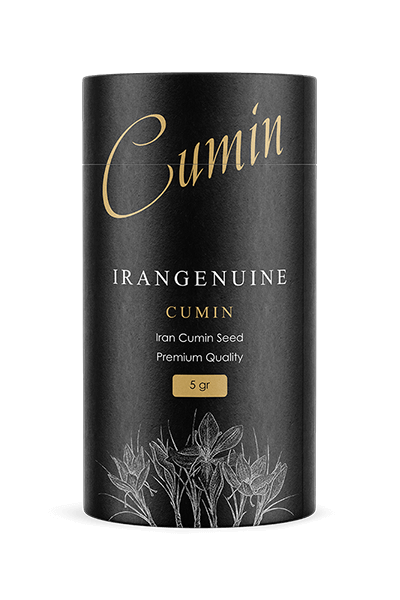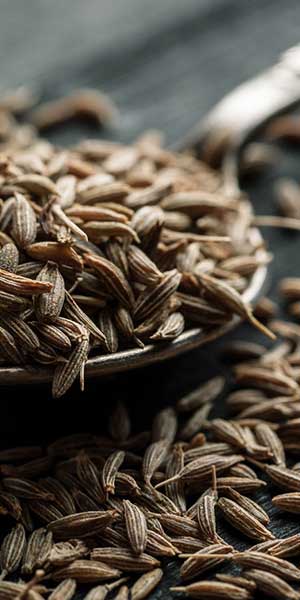
Fat (Per 100 gr)
22 g
Calories (Per 100 gr)
375 Kcal
Carbs (Per 100 gr)
44 g
Chol (Per 100 gr)
0 mg
Cumin (Iran Zira)
This spice is a dried and fragrant seed of the parsley family. The plant grows to 30–50 cm (12–20 in) tall and is harvested by hand. It has a branched stem that is 20–30 cm (8–12 in) tall and has a diameter of 3–5 cm (1 1⁄4–2 in). Each branch has two to three sub-branches. All the branches attain the same height, so the plant has a uniform canopy. The stem is colored grey or dark green. The leaves are 5–10 cm (2–4 in) long. The flowers are small, white or pink.
The seeds have eight ridges with oil canals. They resemble caraway seeds, being oblong in shape, longitudinally ridged, and yellow-brown in color. This seed is self-grown in countries of Afghanistan, Iran, Uzbekistan, Tajikistan, Turkey, Morocco, Egypt, India, Cuba, Syria, Mexico, and Chile. Kerman, in Iran, grows this plant for the most part. The best quality of this product belongs to the town of Baft in Kerman Province, which is self-grown.

Iran Cumin
The local consumption, unlike India, is very limited and major Product is available for Exports. America, Europe, and the Middle-East countries remain the main target buyer’s for Iranian Cumin seed. Iranian seed production plays an important role in the determination of prices of other origins in the International market as Iran is one of the major exporters of seeds to the World Market.
Cumin Usage
- Cumin powder mixed with the rice
- Green type herbal tea
- Drink for weight loss
- Cumin powder with yogurt for weight loss
- Extract, Essence
- Good for cleansing the skin
- Decoction for stopping nose bleeding
- Decoction prevents bleeding in the eye veins
- Reeling the decoction relieves toothache
- Treatment of flatulence with the help of this spice
Cultivation and production
Cultivation areas
The main producers of cumin plant are China and India, which produces 70% of the world supply and consumes 90% of that (which means that India consumes 63% of the world's). Mexico is another major producer. In total, around 300,000 tons of this spice per year are produced worldwide. In Iran, cumin seed is mainly produced in the Khorasan Province with around 4,000 hectares of area under Cultivation and an estimated Production of 15,000 Metric Tons.
Climatic Requirements
The cumin plant is a drought-tolerant, tropical, or subtropical crop. It has a growing season of 100 to 120 days. The optimum growth temperature ranges are between 25 and 30 °C. The Mediterranean climate is most suitable for its growth. Cultivation of that requires a long, hot summer of three to four months. At low temperatures, leaf color changes from green to purple. The high temperature might reduce the growth period and induce early ripening. In India, The plant is sown from October until the beginning of December, and harvesting starts in February. In Syria and Iran, it is sown from mid-November until mid-December (extensions up to mid-January are possible) and harvested in June/July.
Cumin Plant
Spring Planting
-
1
Planting
February, March
-
2
Harvesting
October, November
Autumn Planting
-
1
Planting
November, December
-
2
Harvesting
June, July

Cumin Types
-
Green Zira
-
Black Zira
Black cumin (or mountain type) is known after Kermani one, one of the most famous souvenirs of Kerman Province. Green cumin is one of the types, which is both self-grown and bred by farmer.
Consumption and Benefits of Cumin
This spice can be used as cumin powder or as whole seeds. It imparts an earthy, warming and aromatic character to food, making it a staple in certain stews and soups, as well as spiced gravies such as curry and chili. It is also used as an ingredient in some pickles and pastries. In traditional medicine practices of several countries, dried cumin seeds are believed to have medicinal purposes, although there is no scientific evidence for any use as a drug or medicine. The seeds are often known as substitute medicine for natural treatment of constipation, stomach irritation, stomach burning during menstruation, nausea.
Cumin Benefits
- Promotes Digestion
- Is a Rich Source of Iron
- Contains Beneficial Plant Compounds
- May Help with Diabetes
- May Improve Blood Cholesterol
- May Promote Weight Loss and Fat Reduction
- May Prevent Food-Borne Illnesses
- May Help with Drug Dependence
- May Fight Inflammation
Chewing some cumin is very useful to eliminate bad breath, the smell of garlic and onion.
